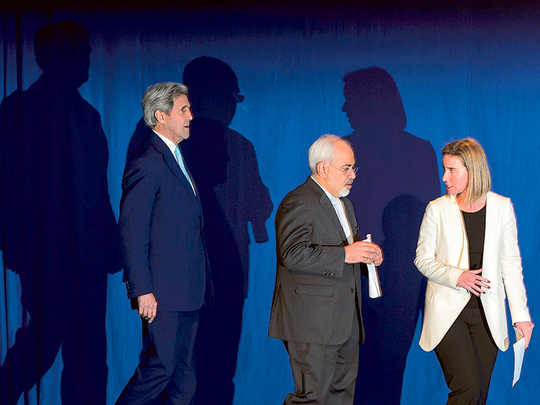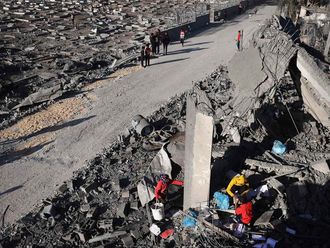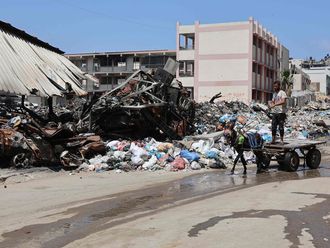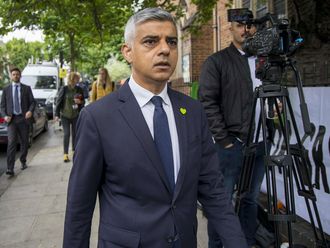
Washington: Negotiators at the nuclear talks in Switzerland emerged from marathon talks April 2 with a surprisingly detailed outline of the agreement they now must work to finalize by the end of June.
But one problem is that there are two versions.
The only joint document issued publicly was a statement from Mohammad Javad Zarif, Iran’s foreign minister, and Federica Mogherini, the European Union foreign policy chief, that was all of seven paragraphs.
The statement listed about a dozen “parameters” that are to guide the next three months of talks, including the commitment that Iran’s Natanz installation will be the only location at which uranium is enriched during the life of the agreement.
But the United States and Iran have also made public more detailed accounts of their agreements in Lausanne, and those accounts underscore their expectations for what the final accord should say.
A careful review shows that there is considerable overlap between the two accounts but also some noteworthy differences - which have raised the question of whether the two sides are entirely on the same page, especially on the question of how quickly sanctions are to be removed. The American and Iranian statements do not clarify some critical issues, such as precisely what sort of research Iran will be allowed to undertake on advanced centrifuges during the first 10 years of the accord.
“This is just a work in progress, and those differences in fact sheets indicate the challenges ahead,” said Olli Heinonen, former deputy director general of the International Atomic Energy Agency.
Obama administration officials insist that there is no dispute on what was agreed behind closed doors. But to avoid time-consuming deliberations on what would be said publicly, the two sides decided during the all-night discussions that each would issue its own statement.
US officials acknowledge that they did not inform the Iranians in advance of all the “parameters” the United States would make public in an effort to lock in progress made so far, as well as to strengthen the White House’s case against any move by members of Congress to impose more sanctions against Iran.
“We talked to them and told them that we would have to say some things,” said a senior administration official who could not be identified under the protocol for briefing reporters. “We didn’t show them the paper. We didn’t show them the whole list.”
The official acknowledged that it was “understood that we had different narratives, but we wouldn’t contradict each other.”
No sooner were the negotiations over April 2, however, than Zarif sent out a tweet that dismissed the five-page set of US parameters as “spin.”
In an appearance on Iranian state television on April 4, Zarif kept up that refrain, saying that Iran had formally complained to Secretary of State John Kerry that the measures listed in the US statement were “in contradiction” to what had actually been accepted in Lausanne.
Zarif, however, did not challenge any nuclear provisions in the US document. Instead, he complained that the paper had been drawn up under Israeli and congressional pressure, and he restated Iran’s insistence on fast sanctions relief, including the need to “terminate,” not just suspend, European Union sanctions.
David Albright, president of the Institute for Science and International Security and an expert who has closely monitored the nuclear talks, said Zarif and President Hassan Rouhani of Iran may be engaged in their own spin to camouflage the significance of the concessions they made.
“Iran conceded a considerable amount in this deal, and Zarif and Rouhani may want to break the news back home slowly,” Albright said.
Assuming that was the Iranians’ motivation, Albright noted a potential downside to the tactics.
“When negotiations resume, Iran may believe it created additional room to backtrack on its commitments, assuming the US is right about what was agreed in the room,” he added.
“We fully expected them to emphasize things that are helpful in terms of selling this at home,” said a second Obama administration official, who was granted anonymity to discuss the deliberations. “We believe that everything in our document will not need to be renegotiated.”
But with three months of hard bargaining ahead, some experts worry that the lack of an agreed-upon, detailed public framework can only complicate the negotiations - and may even invite the Iranians to try to relitigate the terms of the Lausanne deal.
“I think it is a troubling development,” said Ray Takeyh, a senior fellow at the Council on Foreign Relations, who has been critical of the Obama administration’s handling of the talks. “They will exploit all ambiguities with creative interpretations.”












